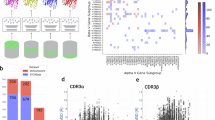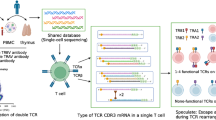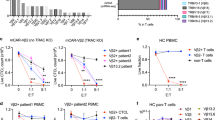Abstract
A multitude of different antigens can be recognized by T cells through specific receptors. Both the α- and β-chains of the T-cell receptor contribute to the antigen recognition portion1. The repertoire of β-chain variable region (Vβ) gene segments is limited to some 20 elements2–4 which seem to be used randomly in different T cells2,5,6. Diversity at the β-chain level can be created in several ways2,3,7–12: a multiplicity of germline gene segments; combinatorial diversity by rearranging different V, diversity (D), joining (J) and constant (C) region elements; junctional diversity by joining gene segments at different sites; N-region diversity, that is, insertion of random nucleotides at junctional sites; and somatic mutation13. However, the major sources and the extent of diversity of the T-cell receptor are unclear. To address this issue, 42 H–2Kb-restricted, 2,4,6-trinitrophenyl (TNP)-specific cytotoxic T-cell (Tc) clones from C57BL/6 mice were characterized with respect to expression of different β-chain gene segments in messenger RNA using specific oligonucleotide probes. We report here that nearly half of the Tc clones use identical elements for productive β-chain gene rearrangement. Thus, there is a restriction in the use of β-chain gene segments in this panel of Tc clones which favours a particular Vβ–Dβ–Jβ–Cβ combination with a defined Dβ element.
This is a preview of subscription content, access via your institution
Access options
Subscribe to this journal
Receive 51 print issues and online access
$199.00 per year
only $3.90 per issue
Buy this article
- Purchase on SpringerLink
- Instant access to full article PDF
Prices may be subject to local taxes which are calculated during checkout
Similar content being viewed by others
References
Yagüe, J. et al. Cell 42, 81–87 (1985).
Barth, R. K. et al. Nature 316, 517–523 (1985).
Behlke, M. A. et al. Science 229, 566–570 (1985).
Davis, M. M. A. Rev. Immun. 3, 537–560 (1985).
Goverman, J. et al. Cell 40, 859–867 (1985).
Rupp, F., Acha-Orbea, H., Hengartner, H., Zinkernagel, R. & Joho, R. Nature 315, 425–427 (1985).
Chien, Y., Gascoigne, N. R. J., Lee, N., Kavaler, J. & Davis, M. M. Nature 309, 322–327 (1984).
Malissen, M. et al. Cell 37, 1101–1110 (1984).
Gascoigne, N. R. J., Chien, Y. H., Becker, D. M., Kavaler, J. & Davis, M. M. Nature 310, 387–391 (1984).
Kavaler, J., Davis, M. M. & Chien, Y.-H. Nature 310, 421–423 (1984).
Siu, G. et al. Nature 311, 344–350 (1984).
Patten, P. et al. Nature 312, 40–46 (1984).
Augustin, A. A. & Sim, G. K. Cell 39, 5–12 (1984).
Weltzien, H. U., Kempkes, B., Jankovic, D. L. & Eichmann, K. Eur. J. Immun. 16, 631–639 (1986).
Hedrick, S. M. et al. Proc. natn. Acad. Sci. U.S.A. 82, 531–535 (1985).
Schilling, J., Clevinger, B., Davie, J. W. & Hood, L. Nature 183, 35–40 (1980).
Gearhart, P. J., Johnson, N. D., Douglas, R. & Hood, L. Nature 291, 29–34 (1981).
Kaartinen, M., Griffiths, G. M., Markham, A. F. & Milstein, C. Nature 304, 320–324 (1983).
Manser, T., Huang, S.-Y. & Gefter, M. L. Science 226, 1283–1288 (1984).
Gridley, T., Margolies, M. N. & Gefter, M. J. Immun. 134, 1236–1244 (1985).
Radbruch, A. et al. Nature 315, 506–508 (1985).
Benton, W. D. & Davis, R. W. Science 196, 180–182 (1977).
Rinaldy, A., Wallace, R. B., Simon, M. M., Becker, A. & Epplen, J. T. Immunogenetics 21, 403–406 (1985).
Sanger, F., Coulson, A. R., Barell, B. G., Smith, A. J. H. & Roe, B. J. molec. Biol. 143, 161–178 (1980).
Chirgwin, J. M., Przybyla, A. E., MacDonald, R. J. & Rutter, W. J. Biochemistry 18, 5294–5299 (1979).
Thomas, P. S. Proc. natn. Acad. Sci. U.S.A. 77, 5201–5205 (1980).
Tsao, S. G. S., Brunk, C. F. & Pearlman, R. E. Analyt. Biochem. 131, 365–372 (1983).
Miyada, C. G., Reyes, A. A., Studencki, A. B. & Wallace, R. B. Proc. natn. Acad. Sci. U.S.A. 82, 2890–2894 (1985).
Shearer, G. M. Eur. J. Immun. 4, 527–533 (1974).
Fujiwara, H. & Shearer, G. A. J. Immun. 126, 1047–1051 (1981).
Maniatis, T., Fritsch, E. F. & Sambrook, J. Molecular Cloning: A Laboratory Manual (Cold Spring Harbor Laboratory, New York, 1982).
Author information
Authors and Affiliations
Rights and permissions
About this article
Cite this article
Hochgeschwender, U., Weltzien, H., Eichmann, K. et al. Preferential expression of a defined T-cell receptor β-chain gene in hapten-specific cytotoxic T-cell clones. Nature 322, 376–378 (1986). https://doi.org/10.1038/322376a0
Received:
Accepted:
Issue date:
DOI: https://doi.org/10.1038/322376a0
This article is cited by
-
Bias in the αβ T‐cell repertoire: implications for disease pathogenesis and vaccination
Immunology & Cell Biology (2011)
-
Highly conserved T-cell receptor junctional regions. Evidence for selection at the protein and the DNA level
Immunogenetics (1990)
-
The antigen receptor of an autoreactive T-cell clone from human rheumatic synovia
Immunogenetics (1989)
-
Suppression of experimentally induced autoimmune encephalomyelitis by cytolytic T–T cell interactions
Nature (1988)
-
Dominance of one T-cell receptor in the H–2Kb/TNP response
Nature (1987)



